Abstract
In the past few years, there appears to have been a change in the spectrum of disease caused by group A beta-haemolytic streptococcus (GABHS), and a toxic shock-like syndrome caused by this organism has recently been described in adults. We report four children with an acute illness characterised by rapid progression of shock, erythematous rash, multisystem organ involvement, electrolyte derangements, and desquamation who fulfil the previously established diagnostic criteria for toxic shock syndrome. Three of the children had extensive cutaneous and soft tissue infection and the fourth had peritonitis. All four developed bacteraemia. Treatment included aggressive cardiovascular resuscitation and antibiotic therapy. Although no patient died, they suffered multiple and severe complications requiring prolonged treatment and hospitalisation. Streptococcal toxic shock syndrome is a separate and clearly defined entity occurring in previously healthy children.
Full text
PDF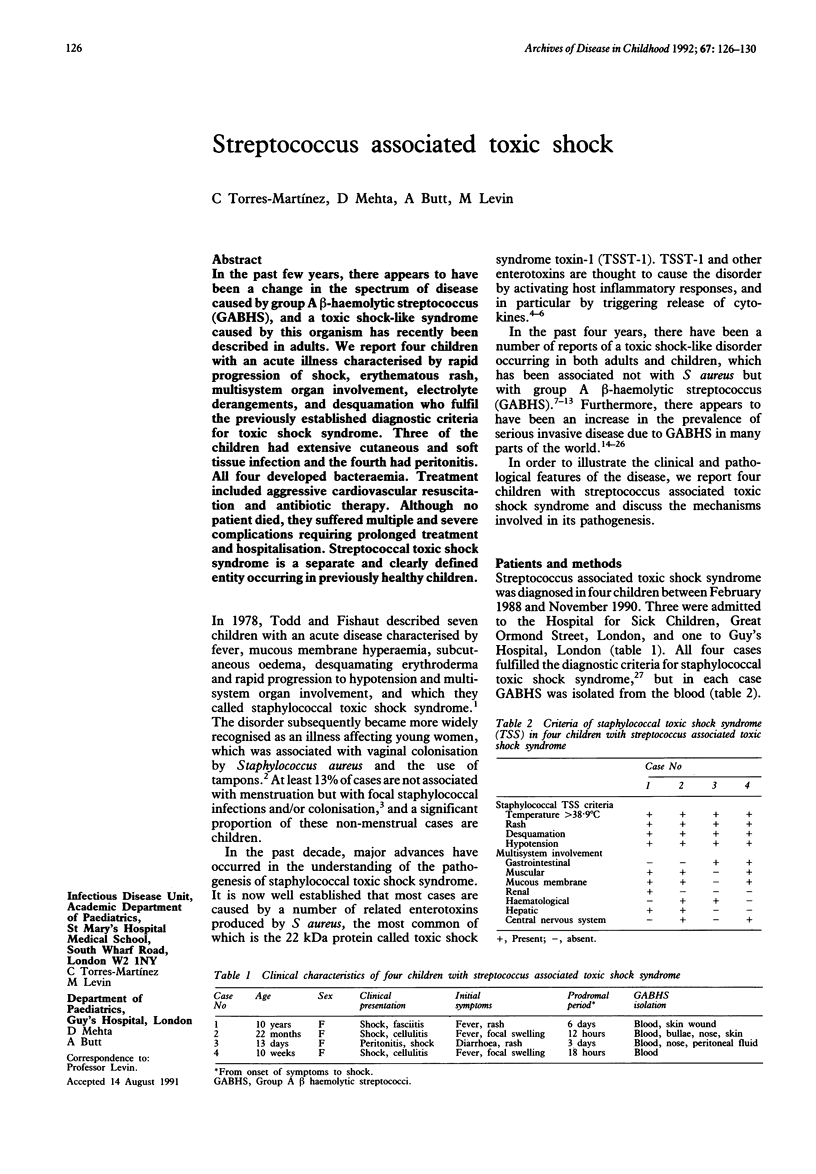
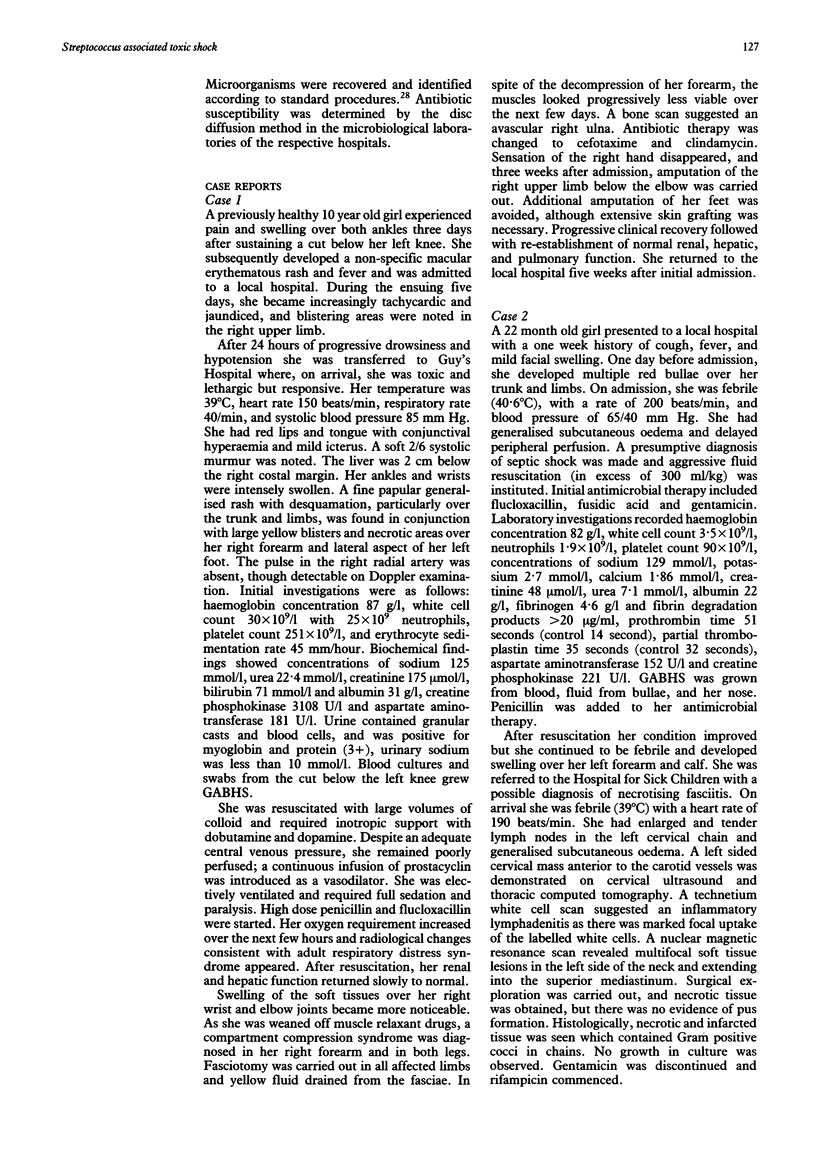
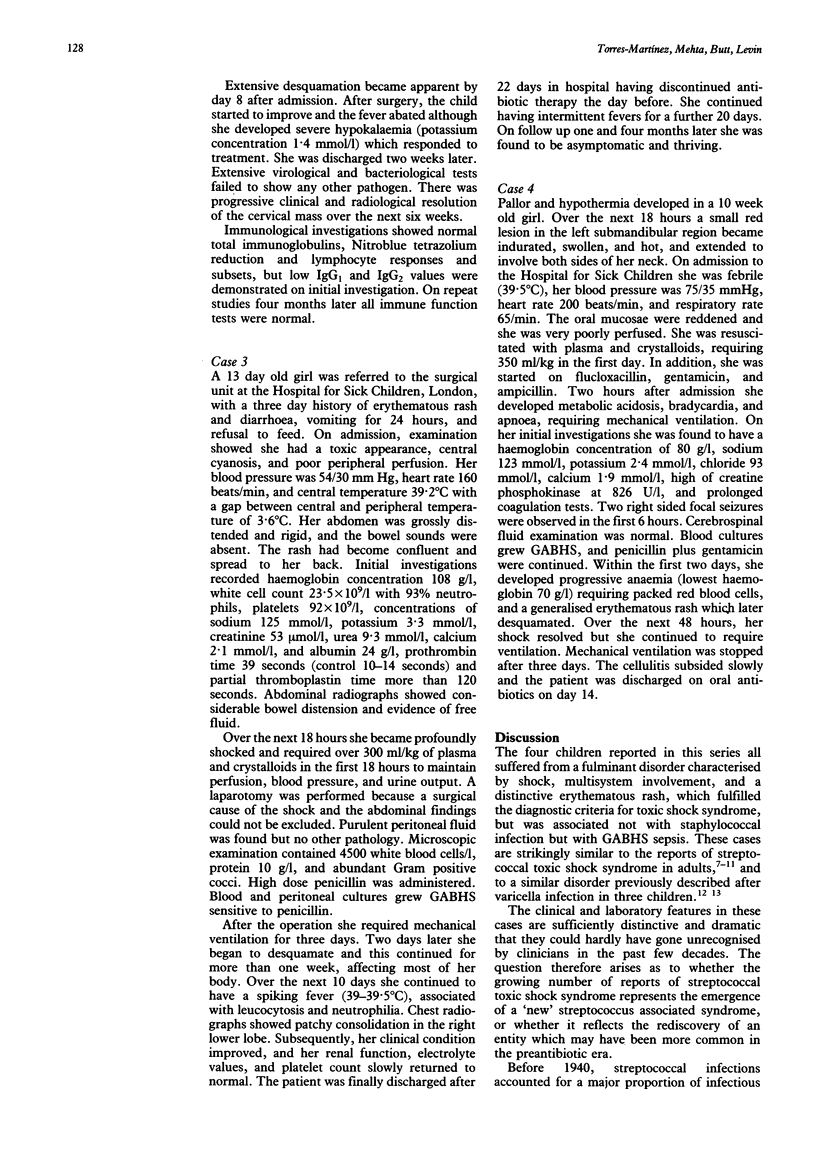
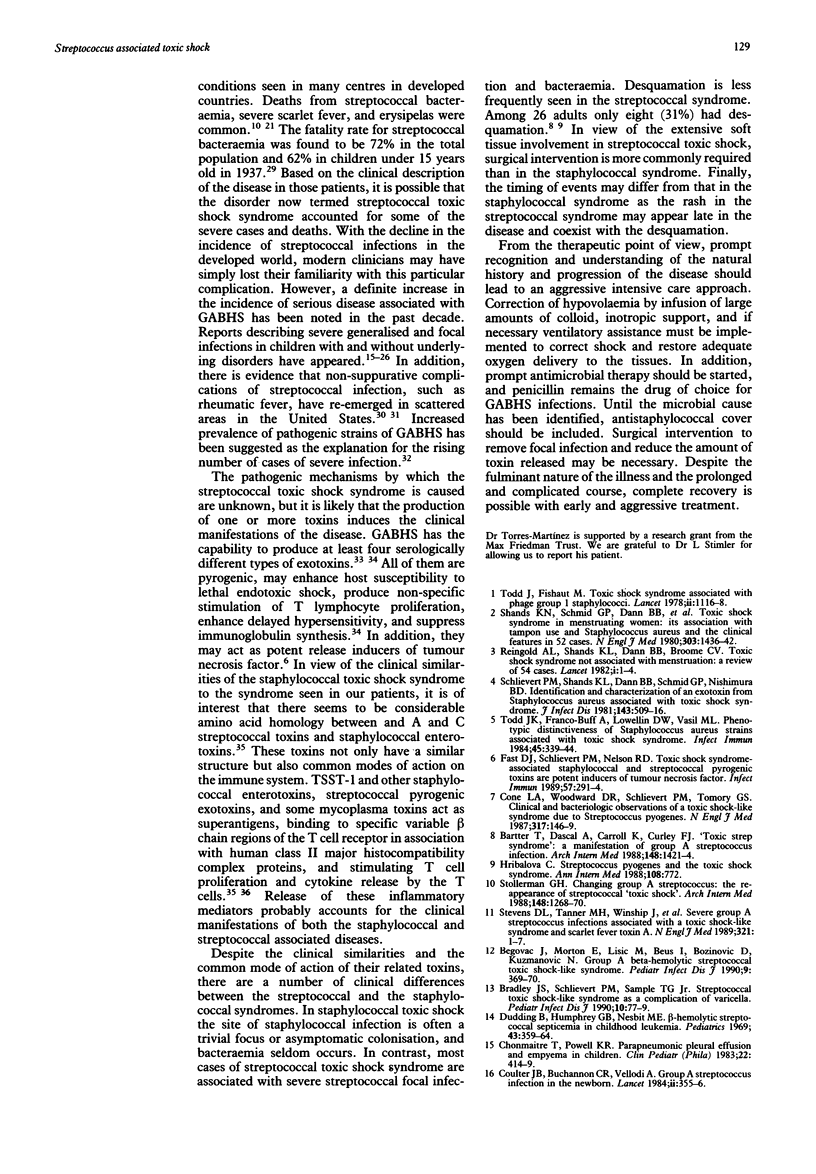
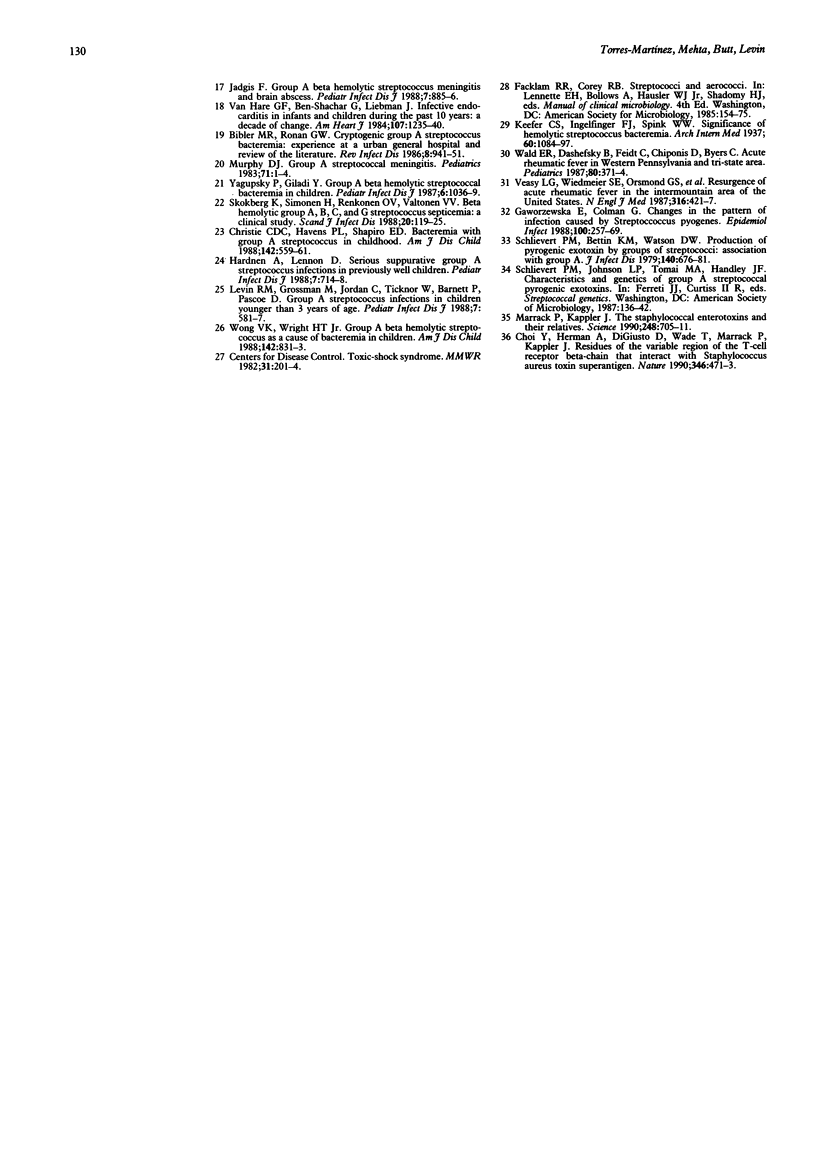
Selected References
These references are in PubMed. This may not be the complete list of references from this article.
- Bartter T., Dascal A., Carroll K., Curley F. J. 'Toxic strep syndrome'. A manifestation of group A streptococcal infection. Arch Intern Med. 1988 Jun;148(6):1421–1424. doi: 10.1001/archinte.148.6.1421. [DOI] [PubMed] [Google Scholar]
- Begovac J., Marton E., Lisić M., Beus I., Bozinović D., Kuzmanović N. Group A beta-hemolytic streptococcal toxic shock-like syndrome. Pediatr Infect Dis J. 1990 May;9(5):369–370. doi: 10.1097/00006454-199005000-00013. [DOI] [PubMed] [Google Scholar]
- Bibler M. R., Rouan G. W. Cryptogenic group A streptococcal bacteremia: experience at an urban general hospital and review of the literature. Rev Infect Dis. 1986 Nov-Dec;8(6):941–951. doi: 10.1093/clinids/8.6.941. [DOI] [PubMed] [Google Scholar]
- Bradley J. S., Schlievert P. M., Sample T. G., Jr Streptococcal toxic shock-like syndrome as a complication of varicella. Pediatr Infect Dis J. 1991 Jan;10(1):77–79. doi: 10.1097/00006454-199101000-00017. [DOI] [PubMed] [Google Scholar]
- Choi Y. W., Herman A., DiGiusto D., Wade T., Marrack P., Kappler J. Residues of the variable region of the T-cell-receptor beta-chain that interact with S. aureus toxin superantigens. Nature. 1990 Aug 2;346(6283):471–473. doi: 10.1038/346471a0. [DOI] [PubMed] [Google Scholar]
- Chonmaitree T., Powell K. R. Parapneumonic pleural effusion and empyema in children. Review of a 19-year experience, 1962-1980. Clin Pediatr (Phila) 1983 Jun;22(6):414–419. doi: 10.1177/000992288302200603. [DOI] [PubMed] [Google Scholar]
- Christie C. D., Havens P. L., Shapiro E. D. Bacteremia with group A streptococci in childhood. Am J Dis Child. 1988 May;142(5):559–561. doi: 10.1001/archpedi.1988.02150050097042. [DOI] [PubMed] [Google Scholar]
- Cone L. A., Woodard D. R., Schlievert P. M., Tomory G. S. Clinical and bacteriologic observations of a toxic shock-like syndrome due to Streptococcus pyogenes. N Engl J Med. 1987 Jul 16;317(3):146–149. doi: 10.1056/NEJM198707163170305. [DOI] [PubMed] [Google Scholar]
- Coulter J. B., Buchannon C. R., Vellodi A., Hart C. A., Sills J. A. Group-A streptococcal infection in the newborn. Lancet. 1984 Aug 11;2(8398):355–356. doi: 10.1016/s0140-6736(84)92727-2. [DOI] [PubMed] [Google Scholar]
- Dudding B., Humphrey G. B., Nesbit M. E. Beta-hemolytic streptococcal septicemias in childhood leukemia. Pediatrics. 1969 Mar;43(3):359–364. [PubMed] [Google Scholar]
- Fast D. J., Schlievert P. M., Nelson R. D. Toxic shock syndrome-associated staphylococcal and streptococcal pyrogenic toxins are potent inducers of tumor necrosis factor production. Infect Immun. 1989 Jan;57(1):291–294. doi: 10.1128/iai.57.1.291-294.1989. [DOI] [PMC free article] [PubMed] [Google Scholar]
- Gaworzewska E., Colman G. Changes in the pattern of infection caused by Streptococcus pyogenes. Epidemiol Infect. 1988 Apr;100(2):257–269. doi: 10.1017/s095026880006739x. [DOI] [PMC free article] [PubMed] [Google Scholar]
- Harnden A., Lennon D. Serious suppurative group A streptococcal infections in previously well children. Pediatr Infect Dis J. 1988 Oct;7(10):714–718. doi: 10.1097/00006454-198810000-00010. [DOI] [PubMed] [Google Scholar]
- Hríbalová V. Streptococcus pyogenes and the toxic shock syndrome. Ann Intern Med. 1988 May;108(5):772–772. doi: 10.7326/0003-4819-108-5-772_2. [DOI] [PubMed] [Google Scholar]
- Levin R. M., Grossman M., Jordan C., Ticknor W., Barnett P., Pascoe D. Group A streptococcal infection in children younger than three years of age. Pediatr Infect Dis J. 1988 Aug;7(8):581–587. [PubMed] [Google Scholar]
- Marrack P., Kappler J. The staphylococcal enterotoxins and their relatives. Science. 1990 May 11;248(4956):705–711. doi: 10.1126/science.2185544. [DOI] [PubMed] [Google Scholar]
- Murphy D. J., Jr Group A streptococcal meningitis. Pediatrics. 1983 Jan;71(1):1–5. [PubMed] [Google Scholar]
- Reingold A. L., Dan B. B., Shands K. N., Broome C. V. Toxic-shock syndrome not associated with menstruation. A review of 54 cases. Lancet. 1982 Jan 2;1(8262):1–4. doi: 10.1016/s0140-6736(82)92552-1. [DOI] [PubMed] [Google Scholar]
- Schlievert P. M., Bettin K. M., Watson D. W. Production of pyrogenic exotoxin by groups of streptococci: association with group A. J Infect Dis. 1979 Nov;140(5):676–681. doi: 10.1093/infdis/140.5.676. [DOI] [PubMed] [Google Scholar]
- Schlievert P. M., Shands K. N., Dan B. B., Schmid G. P., Nishimura R. D. Identification and characterization of an exotoxin from Staphylococcus aureus associated with toxic-shock syndrome. J Infect Dis. 1981 Apr;143(4):509–516. doi: 10.1093/infdis/143.4.509. [DOI] [PubMed] [Google Scholar]
- Shands K. N., Schmid G. P., Dan B. B., Blum D., Guidotti R. J., Hargrett N. T., Anderson R. L., Hill D. L., Broome C. V., Band J. D. Toxic-shock syndrome in menstruating women: association with tampon use and Staphylococcus aureus and clinical features in 52 cases. N Engl J Med. 1980 Dec 18;303(25):1436–1442. doi: 10.1056/NEJM198012183032502. [DOI] [PubMed] [Google Scholar]
- Skogberg K., Simonen H., Renkonen O. V., Valtonen V. V. Beta-haemolytic group A, B, C and G streptococcal septicaemia: a clinical study. Scand J Infect Dis. 1988;20(2):119–125. doi: 10.3109/00365548809032427. [DOI] [PubMed] [Google Scholar]
- Stevens D. L., Tanner M. H., Winship J., Swarts R., Ries K. M., Schlievert P. M., Kaplan E. Severe group A streptococcal infections associated with a toxic shock-like syndrome and scarlet fever toxin A. N Engl J Med. 1989 Jul 6;321(1):1–7. doi: 10.1056/NEJM198907063210101. [DOI] [PubMed] [Google Scholar]
- Stollerman G. H. Changing group A streptococci. The reappearance of streptococcal 'toxic shock'. Arch Intern Med. 1988 Jun;148(6):1268–1270. doi: 10.1001/archinte.148.6.1268. [DOI] [PubMed] [Google Scholar]
- Todd J. K., Franco-Buff A., Lawellin D. W., Vasil M. L. Phenotypic distinctiveness of Staphylococcus aureus strains associated with toxic shock syndrome. Infect Immun. 1984 Aug;45(2):339–344. doi: 10.1128/iai.45.2.339-344.1984. [DOI] [PMC free article] [PubMed] [Google Scholar]
- Todd J., Fishaut M., Kapral F., Welch T. Toxic-shock syndrome associated with phage-group-I Staphylococci. Lancet. 1978 Nov 25;2(8100):1116–1118. doi: 10.1016/s0140-6736(78)92274-2. [DOI] [PubMed] [Google Scholar]
- Van Hare G. F., Ben-Shachar G., Liebman J., Boxerbaum B., Riemenschneider T. A. Infective endocarditis in infants and children during the past 10 years: a decade of change. Am Heart J. 1984 Jun;107(6):1235–1240. doi: 10.1016/0002-8703(84)90283-7. [DOI] [PubMed] [Google Scholar]
- Veasy L. G., Wiedmeier S. E., Orsmond G. S., Ruttenberg H. D., Boucek M. M., Roth S. J., Tait V. F., Thompson J. A., Daly J. A., Kaplan E. L. Resurgence of acute rheumatic fever in the intermountain area of the United States. N Engl J Med. 1987 Feb 19;316(8):421–427. doi: 10.1056/NEJM198702193160801. [DOI] [PubMed] [Google Scholar]
- Wald E. R., Dashefsky B., Feidt C., Chiponis D., Byers C. Acute rheumatic fever in western Pennsylvania and the tristate area. Pediatrics. 1987 Sep;80(3):371–374. [PubMed] [Google Scholar]
- Wong V. K., Wright H. T., Jr Group A beta-hemolytic streptococci as a cause of bacteremia in children. Am J Dis Child. 1988 Aug;142(8):831–833. doi: 10.1001/archpedi.1988.02150080037016. [DOI] [PubMed] [Google Scholar]
- Yagupsky P., Giladi Y. Group A beta-hemolytic streptococcal bacteremia in children. Pediatr Infect Dis J. 1987 Nov;6(11):1036–1039. [PubMed] [Google Scholar]


